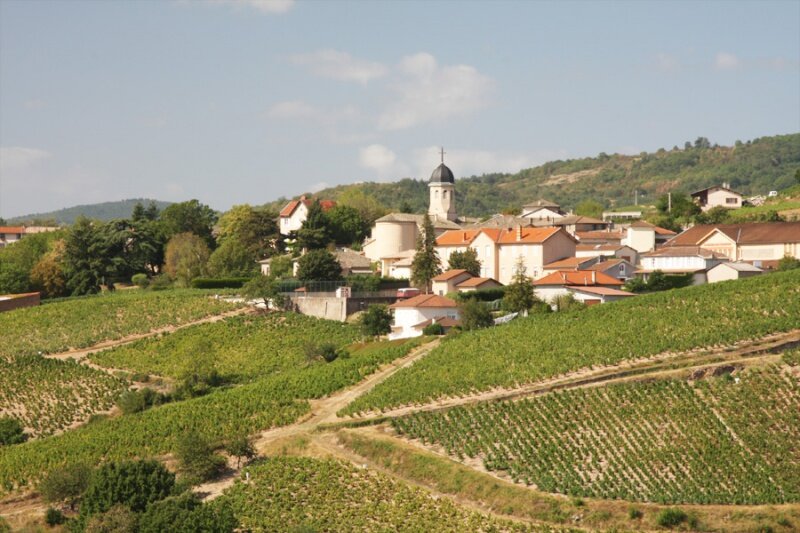France > Beaujolais > Maison Charmelieu
Vineyards around the Mont de Brouilly courtesay Wikimedia commons
Beaujolais: the region
Beaujolais is the southernmost part of the Burgundy region, lying along the east side of the Saone River between the Maconnais and the city of Lyon, where the Saone meets the Rhone on its way out of Switzerland and down to Marseille.
It is a region of rolling hills and small villages, with loose, well-drained acidic soils made of decomposed granites and sandstones. This is Gamay country, a grape that thrives in the sandy soils and moderate climate of the region.
Beaujolais as a whole is about 35 miles long north to south, and 7-9 miles wide. It consists of 96 small villages dotted through the region. The region can be divided into two distinct districts, the Bas-Beaujolais to the south lying on mostly sandstone and clay soils with patches of limestone and the Haut-Beaujolais to the north, lying on thinner, granite and schist based soils.
The region of Beaujolais was first cultivated by the Romans who planted the areas along the Empires trade route up the Saone valley. Two of the princial areas planted were the hill of Brouilly and the region around Morgon. After the dissolution of the Roman Empire, the Benedictine monasteries that thrived in the region took over viticulture and winemaking. In the 15th eentury, the region was ceded by the Lords of Beujeu (whence the name Beaujolais) to the Dukes of Burgundy, who promptly issued edicts banning the more productive Gamay from the “finer” Pinot Noir vineyards to the north. With the expansion of the French railroad system in the 19th century Beaujolais moved from being a local product confined to its own region to being one of the favored cafe wines of Paris, and Beaujolais’ rise to worldwide recognition was begun.
beaujolais nouveau
An unfortunate side effect of that rise to prominence was the explosion in popularity and consequent decline in quality of Beaujolais Nouveau- the light, freshly vinified version traditionally drunk by the harvest workers to celebrate the successful harvest. In fact, Duboeuf, the largest producer of Nouveau, was sued over the quality of the 2004 vintage, and while denying any intentional wrongdoing, the company did settle L’Affaire Duboeuf by destroying over 200,000 liters of wine that was found to be tainted with inferior grade juice. It has to be noted however that although 200,000 liters is a lot of wine, Duboeuf produces some 270 million liters of Nouveau annually, an ocean veritable that could easily float the Titanic.
Maison Charmelieu
Another project from our friend, winemaker and vigneron Michael Shaps, Charmelieu is a boutique negociant, buying small lots of pristine fruit from local growers in the Maconnais and Beaujolais districts, to produce wines that are fresh, balanced and show great typicity of style for their grape and terroir of origin. As with Michael’s other French wines, no herbicides are permitted in the vineyards, and only natural wild yeasts are used in the fermentation
The wines
Maison Charmelieu Chenas: Brght and fresh with scents of berry and a touch of pepper A superb example of a Cru Beaujolais that drinks well young but that will age gracefully.
Maison Charmelieu Morgon: Deeper and more complex with touches of earth, dark plummy fruit and a silky ripeness. A great example of Cru Beaujolais that will improve with age and is best with a couple years of bottle time.
Beaujolais: classification
Over 98% of Beaujolais production is from the Gamay grape, a thin-skinned, relatively high-acidity variety that produces a substantial crop with relative ease. Gamay is a cross between Pinot Noir and Gouais, an ancient Central European variety probably introduced to the area by the Romans. The date of the cross is unknown, but Gamay was well established in the region by the 1400’s.
There are essentially three levels of Beaujolais- Beaujolais AOC, Beaujolais-Villages AOC, and the 10 crus of Beaujolais, individual towns with unique terroirs that produce the finest wines in the region, and typically do not say “beaujolais” anywhere on the label.
The vast majority of Beaujolais AOC (and the large proportion of that which is released as Beaujolais Nouveau each fall shortly after harvest) is produce in the Bas-Beaujolais. These wines are light, bright, fruity and generally inconsequential. The 34 communes granted the Beaujolais-Villages AOC designation all lie in the Haut-Beaujolais to the north. While still light, these wines have more depth, character and sense of the minerality of their terroir.
The ten crus can be divided into three groups. The first are the three lightest crus, designed for drinking within a few years of the vintage. These are Brouilly, Chiroubles and Regnie.
The second group consists of medium-bodied wines that benefit from a year or two in bottle and age well for another 3-4 years. This group includes the Cote de Brouilly (the flanks of the ancient Brouilly volcano), Fleurie and Saint-Amour.
The third group are wines of definite power and intensity that can age comfortably for up to a decade from harvest, including Chenas, Julienas, Morgon and Moulin a Vent.
Gamay clusters showing the coating of wild yeast on these organically-farmed grapes
The famed “pierres dores” of Beaujolais… courtesy visitfrenchwine.com
The Village of Chiroubles, courtesy www.chiroubles.fr






